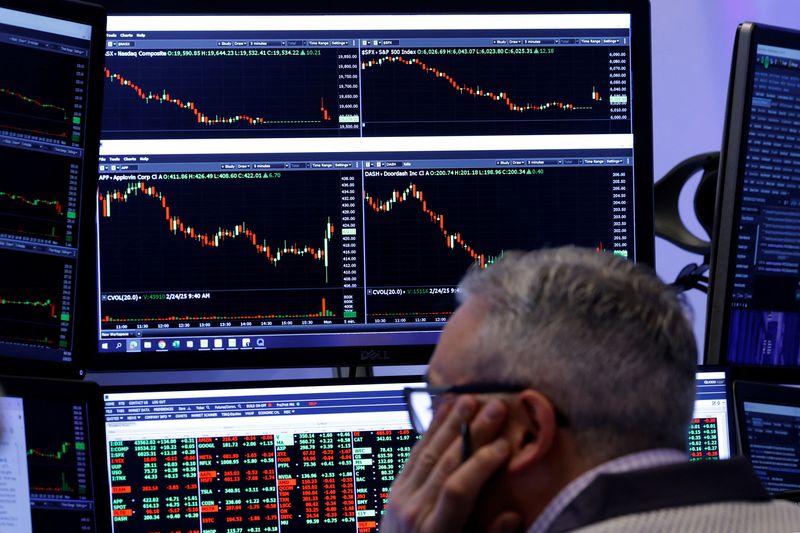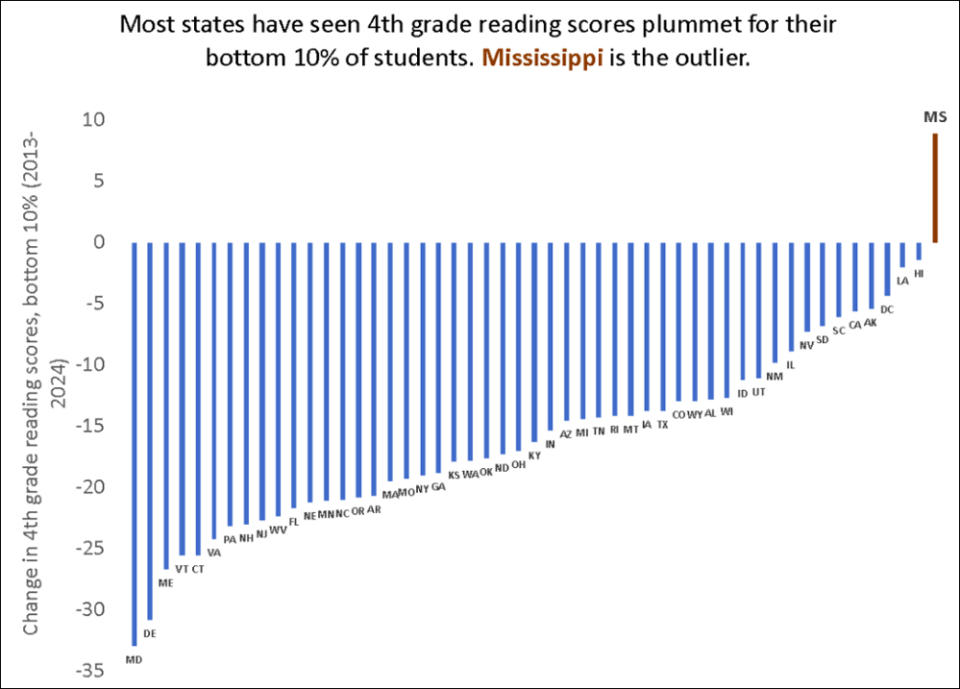
A look at the day ahead in U.S. and global markets from Mike Dolan
Rancorous geopolitics continues to grab most headlines again this week, but it’s creeping anxiety about a slowing U.S. economy that’s unnerving investors most about Wall Street stocks.
Wary of Wednesday’s results from megacap chip giant Nvidia, the S&P500 lost its 6,000 handle for the first time in three weeks on Monday and both the tech-heavy Nasdaq and small cap Russell 2000 are now negative for the year to date.
Even the meagre 1% gain in the S&P500 for 2025 so far is a third of MSCI all-country and far below the 13% gain in Germany’s blue-chip DAX, which was emboldened this week after the election results there and hopes for some fiscal easing.
The VIX ‘fear index’ of S&P500 implied volatility also jumped above 20 for the first time since February 3 and was eyeing up its highest close of the year ahead of today’s bell.
Adding to the tech angst ahead of Nvidia’s update, Chinese mainland and Hong Kong stock indexes both lost more than 1% earlier on Tuesday after a Bloomberg report said President Donald Trump plan to toughen chip restrictions on China – expanding predecessor Joe Biden’s efforts to hamper Beijing’s tech development.
‘ON SCHEDULE’
Keeping trade threats on the front burner, Trump also said overnight that tariffs on Canadian and Mexican imports are “on time and on schedule” despite both countries’ moves on border security and fentanyl trafficking ahead of a March 4 deadline.
And yet market jitters about pricy U.S. stocks were sourced even closer to home, with US stock futures remaining in the red overnight.
Alongside the tech anxiety, the economic numbers this week continue to challenge the ‘no landing’ consensus that has recently built up around direction of overall activity.
With a withering array of new policy initiatives involving import duties, migrant curbs, federal worker cuts and broken international alliances, there’s concern that the uncertainty of the impact is weighing on business and consumer planning.
Retail sales have disappointed into the new year and business surveys are starting to splutter, with one last week showing the dominant U.S. service sector contracting for the first time in two years this month.
The drip-drip of slowing activity was reinforced on Monday by Dallas and Chicago Federal Reserve surveys, too.
The University of Michigan’s household survey on Friday, meantime, shows consumer confidence at 15-month lows in February and the Conference Board’s equivalent consumer sentiment readout today will likely be pivotal during Tuesday’s trading session.
Consensus forecasts are for a drop in the gauge to five-month lows.
The underwhelming picture is captured best by a drop in the U.S. economic surprise index over the past week to its most negative since September.
CONSUMER CONFIDENCE
And there’s also growing fears that any shakeout in stocks from here could well compound a consumer confidence retreat by sapping the ‘wealth effect’ in richer households who dominate retail spending aggregates.
The concern is significant enough to shift the dial on Treasuries too.
Ten-year Treasury yields have plunged to their lowest for the year at 4.33%, clocking losses of 20 basis points in less than two weeks. Two-year yields plumbed as low as 4.11% to their lowest since December 11.
And even Fed futures have sat up and taken notice – with another rate cut now fully priced again before July and more than two full cuts in price for whole year.
In that environment, the dollar has held remarkably steady so far – caught between the domestic economic stumble and yield moves and the pressure of upcoming tariff rises. Mexico’s peso, Canada’s dollar and China’s yuan were marginally weaker.
But the wider market risk environment is fraying at the edges.
Bitcoin plunged back below $90,000 for the first time in a month to hit its lowest since November, shortly after Trump’s election was supposed to usher in some new era for the crypto world.
Elsewhere, the focus continued to be on Europe’s stock outperformance – with cheaper valuations there, repatriation of European money from Wall Street, this week’s German election results and hopes for euro-wide fiscal boosts playing a part.
Despite losses on Wall Street and in China over the past 24 hours, the pan-European STOXX 600 index rose 0.3% on Tuesday.
Fears that a messy U.S.-Kremlin brokered deal to end the Ukraine war without rolling back Russia’s three-year old invasion of the eastern part of the country have sent shockwaves across Europe and defense spending is now a huge priority.
The European aerospace and defence index jumped again on Tuesday, adding 1.3% as traders pointed to reports that Germany was discussing 200 billion euros for an emergency defence fund.
Key developments that should provide more direction to U.S. markets later on Tuesday:
* US Conference Board’s February consumer confidence survey, Richmond Federal Reserve Feb business surveys, Dallas Fed Feb services survey
* Federal Reserve Vice Chair for Supervision Michael Barr, Dallas Fed President Lorie Logan, Richmond Fed chief Thomas Barkin all speak; European Central Bank board member Isabel Schnabel and Bank of England chief economist Huw Pill speak
* US corporate earnings: Home Depot, First Solar, Workday, Keurig Dr Pepper, Public Service Enterprise, Sempra, Pinnacle West, Intuit, Henry Schein, American Tower, Axon, Caesars Entertainment, Keysight, Extra Space Storage etc
* US Treasury sells $70 billion of 5-year notes
(Editing by Bernadette Baum)
EMEA Tribune is not involved in this news article, it is taken from our partners and or from the News Agencies. Copyright and Credit go to the News Agencies, email news@emeatribune.com Follow our WhatsApp verified Channel




